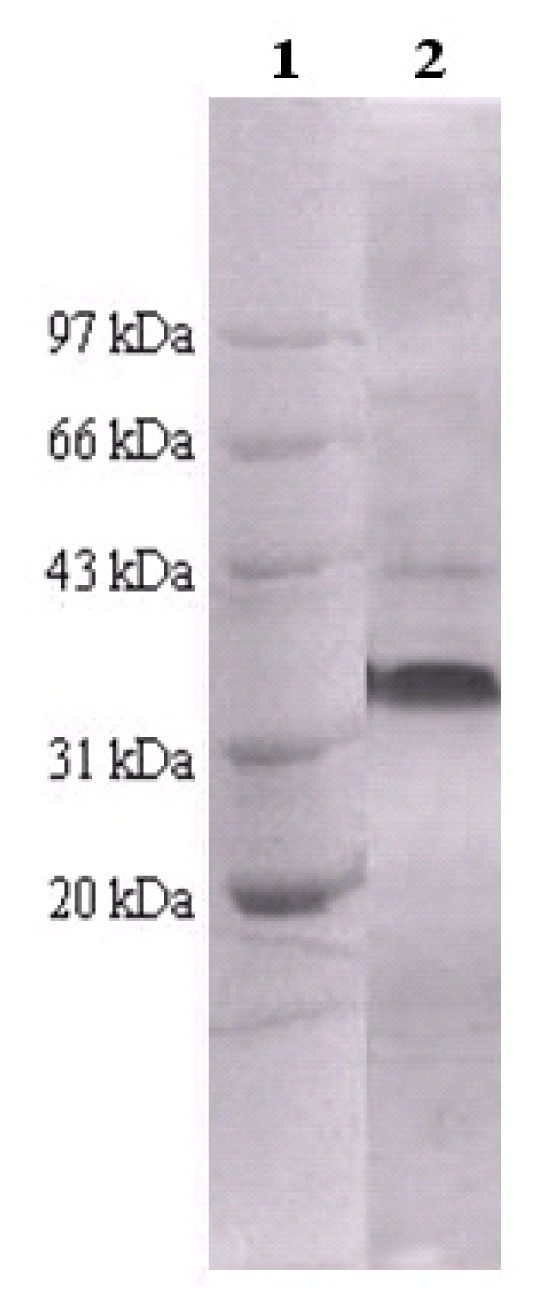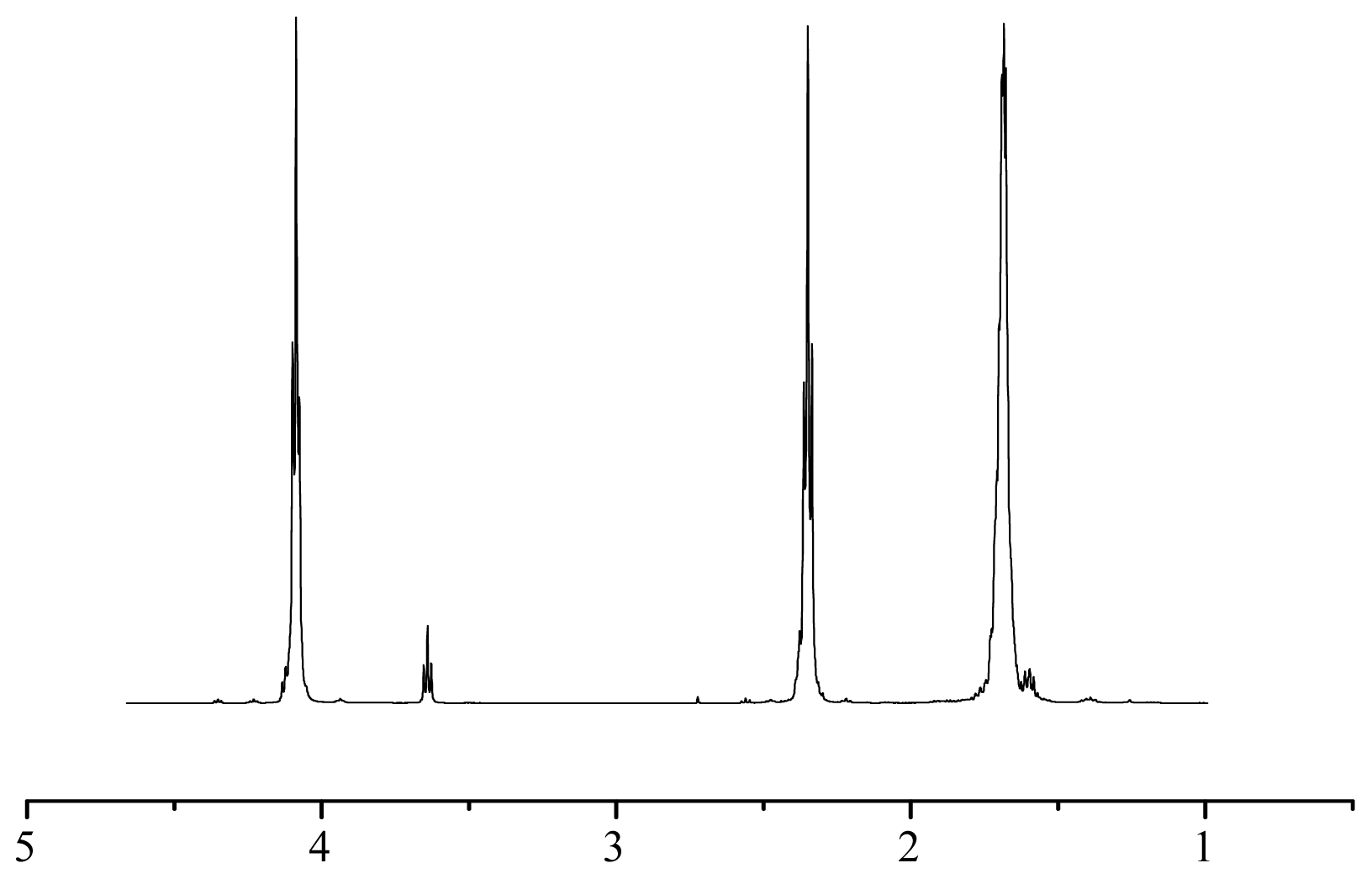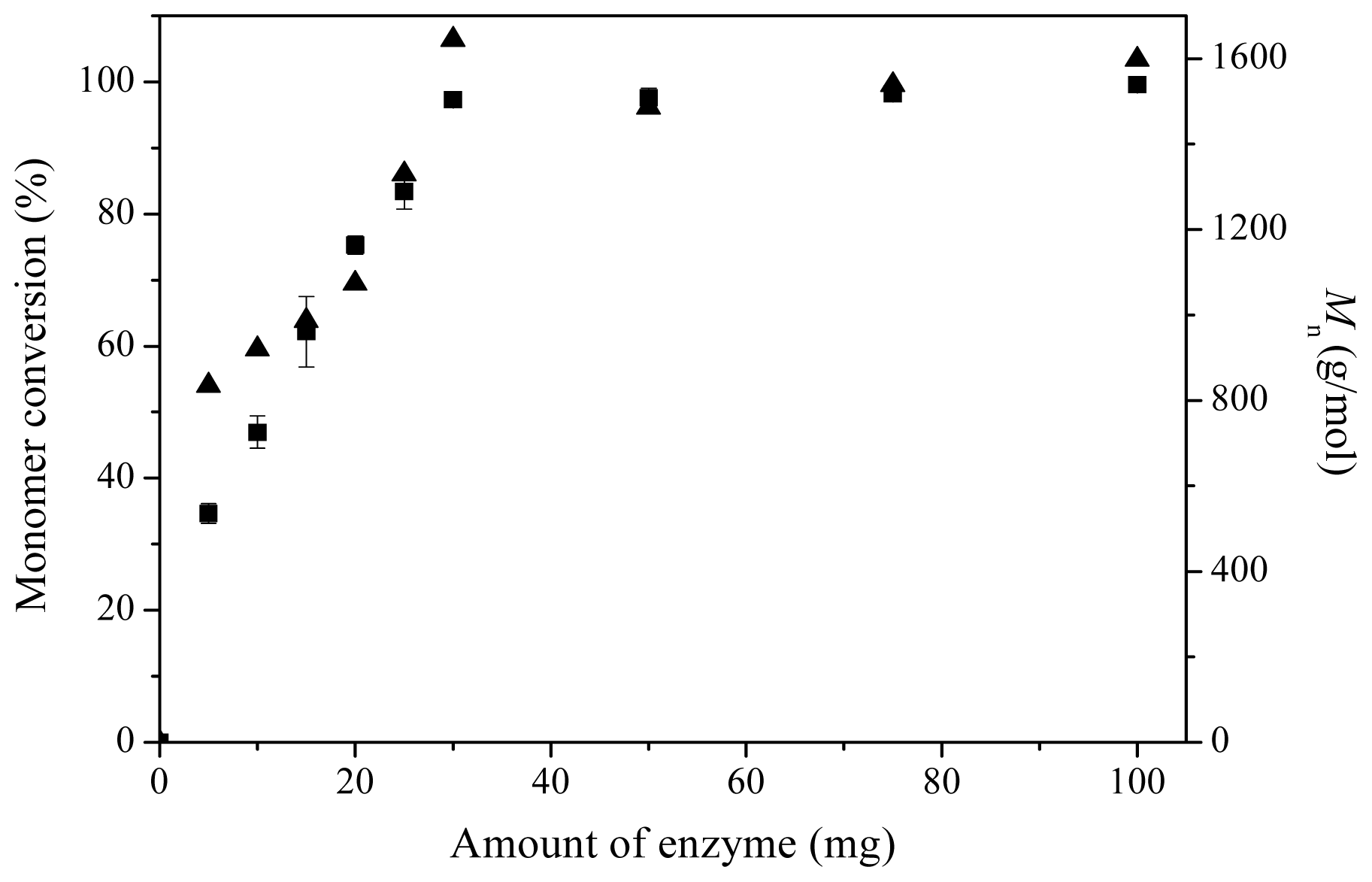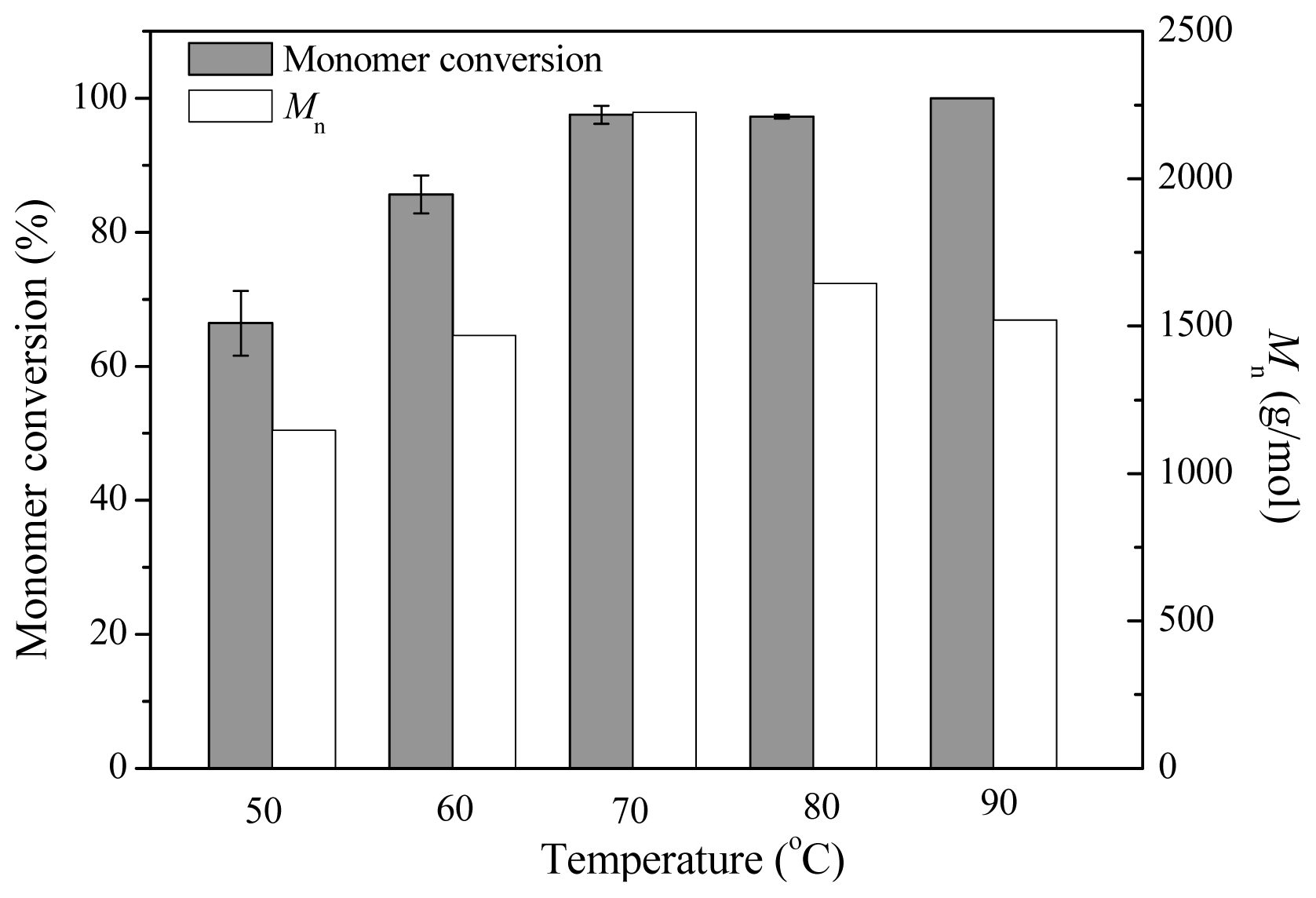Biocatalytic Synthesis of Poly(δ-Valerolactone) Using a Thermophilic Esterase from Archaeoglobus fulgidus as Catalyst
Abstract
:1. Introduction
2. Results and Discussion
2.1. Purification of the Recombinant Enzyme AFEST
2.2. Effect of Enzyme Concentration
2.3. Effect of Temperature
2.4. Effect of Reaction Time
2.5. Effect of Reaction Medium
3. Experimental Section
3.1. Materials
3.2. Purification of the Recombinant Enzyme AFEST
3.3. Enzymatic Ring-Opening Polymerization of δ-Valerolactone
3.4. Structural Characterization of PVL
3.5. Determination of Monomer Conversion
3.6. Determination of Molecular Weight and Polydispersity Index (PDI)
4. Conclusions
Acknowledgments
References
- Nair, L.K.; Jagadeeshan, S.; Nair, S.A.; Kumar, G.S.V. Evaluation of triblock copolymeric micelles of δ-valerolactone and poly (ethylene glycol) as a competent vector for doxorubicin delivery against cancer. J. Nanobiotechnol 2011, 9, 42. [Google Scholar]
- Vaida, C.; Takwa, M.; Martinelle, M.; Hult, K.; Keul, H.; Moller, M. γ-Acyloxy-ɛ-caprolatone: Synthesis, ring-opening polymerization vs. rearrangement by means of chemical and enzymatic catalysis. Macromol. Symp 2008, 272, 28. [Google Scholar]
- D’Auria, I.; Mazzeo, M.; Pappalardo, D.; Lamberti, M.; Pellecchia, C. Ring-opening polymerization of cyclic esters promoted by phosphido-diphosphine pincer group 3 complexes. J. Polym. Sci. A: Polym. Chem 2011, 49, 403–413. [Google Scholar]
- Varma, I.K.; Albertsson, A.C.; Rajkhowa, R.; Srivastava, R.K. Enzyme catalyzed synthesis of polyesters. Prog. Polym. Sci 2005, 30, 949–981. [Google Scholar]
- Kobayashi, S.; Makino, A. Enzymatic polymer synthesis: An opportunity for green polymer chemistry. Chem. Rev 2009, 109, 5288–5353. [Google Scholar]
- Kobayashi, S. Recent developments in lipase-catalyzed synthesis of polyesters. Macromol. Rapid Commun 2009, 30, 237–266. [Google Scholar]
- Kobayashi, S. Lipase-catalyzed polyester synthesis: A green polymer chemistry. Proc. Jpn. Acad. Ser. B 2010, 86, 338–365. [Google Scholar]
- Kadokawa, J.; Kobayashi, S. Polymer synthesis by enzymatic catalysis. Curr. Opin. Chem. Biol 2010, 14, 145–153. [Google Scholar]
- Yang, Y.; Yu, Y.; Zhang, Y.; Liu, C.; Shi, W.; Li, Q. Lipase/esterase-catalyzed ring-opening polymerization: A green polyester synthesis technique. Process Biochem 2011, 46, 1900–1908. [Google Scholar]
- Kobayashi, S.; Takeya, K.; Suda, S.; Uyama, H. Lipase-catalyzed ring-opening polymerization of medium-size lactones to polyesters. Macromol. Chem. Phys 1998, 199, 1729–1736. [Google Scholar]
- Gorke, J.T.; Okrasa, K.; Louwagie, A.; Kazlauskas, R.J.; Srienc, F. Enzymatic synthesis of poly(hydroxyalkanoates) in ionic liquids. J. Biotechnol 2007, 132, 306–313. [Google Scholar]
- Li, Q.; Li, G.; Ma, F.; Zhang, Z.; Zheng, B.; Feng, Y. Highly efficient ring-opening polymerization of ɛ-capaolactone catalyzed by a recombinant Escherichia coli whole-cell biocatalyst. Process Biochem 2011, 46, 477–481. [Google Scholar]
- Van der Mee, L.; Helmich, F.; de Bruijn, R.; Vekemans, J.A.J.M.; Palmans, A.R.A.; Meijer, E.W. Investigation of lipase-catalyzed ring-opening polymerizations of lactones with various ring sizes: Kinetic evaluation. Macromolecules 2006, 39, 5021–5027. [Google Scholar]
- Van Buijtenen, J.; van As, B.A.C.; Verbruggen, M.; Roumen, L.; Vekemans, J.A.J.M.; Pieterse, K.; Hilbers, P.A.J.; Hulshof, L.A.; Palmans, A.R.A.; Meijer, E.W. Switching from S- to R-selectivity in the Candida antarctica lipase B-catalyzed ring-opening of ω-methylated lactones: Tuning polymerizations by ring size. J. Am. Chem. Soc 2007, 129, 7393–7398. [Google Scholar]
- Veld, M.A.J.; Fransson, L.; Palmans, A.R.A.; Meijer, E.W.; Hult, K. Lactone size dependent reactivity in Candida antarctica lipase B: Molecular dynamics and docking study. ChemBioChem 2009, 10, 1330–1334. [Google Scholar]
- D’Auria, S.; Herman, P.; Lakowicz, J.R.; Bertoli, E.; Tanfani, F.; Rossi, M.; Manco, G. The thermophilic esterase from Archaeoglobus fulgidus: Structure and conformational dynamics at high temperature. Proteins 2000, 38, 351–360. [Google Scholar]
- Manco, G.; Giosue, E.; D’Auria, S.; Herman, P.; Carrea, G.; Rossi, M. Cloning, overexpression, and properties of a new thermophilic and thermostable esterase with sequence similarity to hormone-sensitive lipase subfamily from the archaeon Archaeoglobus fulgidus. Arch. Biochem. Biophys 2000, 373, 182–192. [Google Scholar]
- Simone, G.D.; Menchise, V.; Manco, G.; Mandrich, L.; Sorrentino, N.; Lang, D.; Rossi, M.; Pedone, C. The crystal structure of a hyper-thermophilic carboxylesterase from the archaeon Archaeoglobus fulgidus. J. Mol. Biol 2001, 314, 507–518. [Google Scholar]
- Chaninian, H.; Ali, Y.B.; Abousalham, A.; Petry, S.; Mandrich, L.; Manco, G.; Canaan, S.; Sarda, L. Substrate specificity and kinetic properties of enzymes belonging to the hormone-sensitive lipase family: Comparison with non-lipolytic and lipolytic carboxylesterases. Biochim. Biophys. Acta 2005, 1738, 29–36. [Google Scholar]
- Ma, J.; Li, Q.; Song, B.; Liu, D.; Zheng, B.; Zhang, Z.; Feng, Y. Ring-opening polymerization of ɛ-caprolactone catalyzed by a novel thermophilic esterase from the archaeon Archaeoglobus fulgidus. J. Mol. Catal. B: Enzym 2009, 56, 151–157. [Google Scholar]
- Li, G.; Li, Q. Thermophilic esterase from the archaeon Archaeoglobus fulgidus physically immobilized on hydrophobic macroporous resin: A novel biocatalyst for polyester synthesis. Biotechnol. Bioprocess E 2011, 16, 1201–1207. [Google Scholar]
- Ren, X.; Yu, D.; Yu, L.; Gao, G.; Han, S.; Feng, Y. A new study of cell disruption to release recombinant thermostable enzyme from Escherichia coli by thermolysis. J. Biotechnol 2007, 129, 668–673. [Google Scholar]
- Deng, F.; Gross, R.A. Ring-opening bulk polymerization of ɛ-caprolactone and trimethylene carbonate catalyzed by lipase Novozym 435. Int. J. Biol. Macromol 1999, 25, 153–159. [Google Scholar]
- Sivalingam, G.; Madras, G. Modeling of lipase catalyzed ring-opening polymerization of ɛ-caprolatone. Biomacromolecules 2004, 5, 603–609. [Google Scholar]
- Klibanov, A.M. Improving enzymes by using them in organic solvents. Nature 2001, 409, 241–246. [Google Scholar]
- Finding Physical and Chemical Properties. Science and Engineering Library from Vanderbilt University. Available online: http://www.library.vanderbilt.edu/science/chem/property.html#logp accessed on 18 September 2012.
- Dong, H.; Cao, S.; Li, Z.; Han, S.; You, D.; Shen, J. Study on the enzymatic polymerization of mechanism of lactones and the strategy for improving the degree of polymerization. J. Polym. Sci. A: Polym. Chem 1999, 37, 1265–1275. [Google Scholar]
- Chua, L.S.; Sarmidi, M.R. Effect of solvent and initial water content on (R,S)-1-phenylethanol resolution. Enzyme Microb. Technol 2006, 38, 551–556. [Google Scholar]
- Gao, R.; Feng, Y.; Ishikawa, K.; Ishida, H.; Ando, S.; Kosugi, Y.; Cao, S. Cloning, purification and properties of a hyperthermophilic esterase from archaeon Aeropyrum pernix K1. J. Mol. Catal. B: Enzym 2003, 24–25, 1–8. [Google Scholar]





| Solvent | Log P | Monomer conversion (%) | Mn (g/mol) | PDI |
|---|---|---|---|---|
| 1,4-Dioxane | −1.10 | 86 | 860 | 1.09 |
| Acetone | −0.23 | 87 | 850 | 1.12 |
| Tetrahydrofuran | 0.49 | 93 | 910 | 1.10 |
| Dichloromethane | 0.93 | 72 | 860 | 1.14 |
| Chloroform | 2.00 | 91 | 960 | 1.15 |
| Toluene | 2.50 | 97 | 2225 | 1.37 |
| Cyclohexane | 3.09 | 100 | 1860 | 1.28 |
| n-Hexane | 3.50 | 100 | 1970 | 1.29 |
| Solvent-free | - | 94 | 1620 | 1.26 |
© 2012 by the authors; licensee Molecular Diversity Preservation International, Basel, Switzerland. This article is an open-access article distributed under the terms and conditions of the Creative Commons Attribution license (http://creativecommons.org/licenses/by/3.0/).
Share and Cite
Cao, H.; Han, H.; Li, G.; Yang, J.; Zhang, L.; Yang, Y.; Fang, X.; Li, Q. Biocatalytic Synthesis of Poly(δ-Valerolactone) Using a Thermophilic Esterase from Archaeoglobus fulgidus as Catalyst. Int. J. Mol. Sci. 2012, 13, 12232-12241. https://doi.org/10.3390/ijms131012232
Cao H, Han H, Li G, Yang J, Zhang L, Yang Y, Fang X, Li Q. Biocatalytic Synthesis of Poly(δ-Valerolactone) Using a Thermophilic Esterase from Archaeoglobus fulgidus as Catalyst. International Journal of Molecular Sciences. 2012; 13(10):12232-12241. https://doi.org/10.3390/ijms131012232
Chicago/Turabian StyleCao, Hong, Haobo Han, Guangquan Li, Jiebing Yang, Lingfei Zhang, Yan Yang, Xuedong Fang, and Quanshun Li. 2012. "Biocatalytic Synthesis of Poly(δ-Valerolactone) Using a Thermophilic Esterase from Archaeoglobus fulgidus as Catalyst" International Journal of Molecular Sciences 13, no. 10: 12232-12241. https://doi.org/10.3390/ijms131012232




